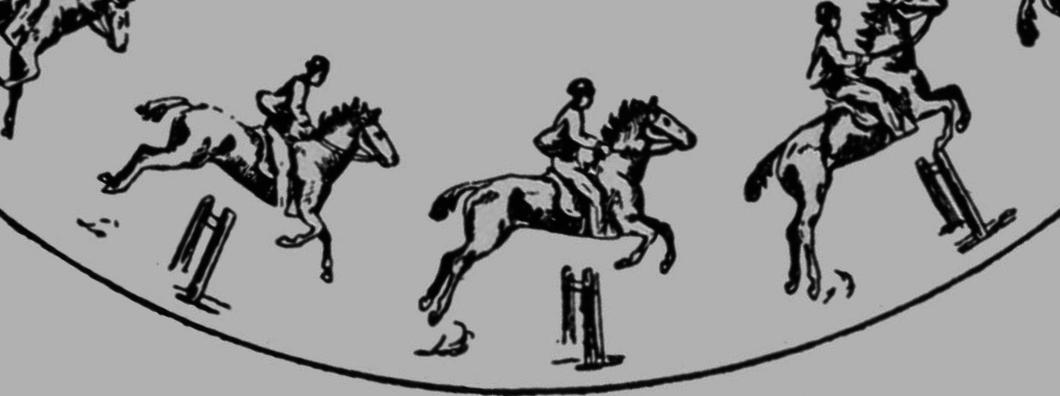|
Bit Converter
In horseback riding, bit converter, also known as a pelham rounding, is used on pelham bits to change them from two-rein bits to one-rein bits. It is a leather strap that attaches from the snaffle ring to the curb ring, onto which the rein is then attached to the loop made between the two rings. A bit converter is very helpful when riding the cross-country phase of eventing, so that a rider using a pelham does not have to keep track of two reins Reins are used to direct a horse (or other animal) when riding or driving. They are attached to a bridle's bit or noseband and are made of leather, nylon, or other materials. Reins are used to give subtle commands or cues—also known as rei ...— especially helpful when riding drop fences, which require the rider to slip the reins and then gather them back up on landing. It is also commonly used by children, who may have not yet become skilled enough to handle two reins with ease. However, the bit converter diminishes the rider's ... [...More Info...] [...Related Items...] OR: [Wikipedia] [Google] [Baidu] |
|
 |
Pelham Bit
A pelham bit is a type of bit used when riding a horse. It has elements of both a curb bit and a snaffle bit. In this respect a pelham bit functions similar to a double bridle, and like a double bridle it normally has "double" reins: a set of curb reins and a set of snaffle reins. Because it has a bit shank and can exert curb-style pressure on the horse, it is considered a curb bit. Accessed November 15, 2008 Like all curb bits, a pelham bit has a mouthpiece, shanks with both purch ... [...More Info...] [...Related Items...] OR: [Wikipedia] [Google] [Baidu] |
|
Eventing
Eventing (also known as three-day eventing or horse trials) is an equestrian event where the same horse and rider combination compete against other competitors across the three disciplines of dressage, cross-country, and show jumping. This event has its roots in a comprehensive cavalry test that required mastery of several types of riding. The competition may be run as a one-day event (ODE), where all three events are completed in one day (dressage, followed by show jumping and then the cross-country phase) or a three-day event (3DE), which is more commonly now run over four days, with dressage on the first two days, followed by cross-country the next day and then show jumping in reverse order on the final day. Eventing was previously known as Combined Training, and the name persists in many smaller organizations. The term "Combined Training" is sometimes confused with the term "Combined Test", which refers to a combination of just two of the phases, most commonly dressage a ... [...More Info...] [...Related Items...] OR: [Wikipedia] [Google] [Baidu] |
|
|
Reins
Reins are used to direct a horse (or other animal) when riding or driving. They are attached to a bridle's bit or noseband and are made of leather, nylon, or other materials. Reins are used to give subtle commands or cues—also known as rein aids—to ask for a turn, a slower speed, a halt, or to go backwards. Types Other uses The word "rein" is sometimes used incorrectly to refer to a lead rope or a longe line, neither of which are reins. The idiom " rein in" means to hold back, slow down, control or limit; often misspelled as " reign in". The idiom " free rein" means to give or allow complete freedom, in action and decision, over something. See also *Horse tack * Neck rein *Riding aids Riding aids are the cues a rider gives to a horse to communicate what they want the animal to do. Riding aids are broken into the ''natural aids'' and the ''artificial aids''. Natural aids ''Natural aids'' are those of the rider's body, and ... [...More Info...] [...Related Items...] OR: [Wikipedia] [Google] [Baidu] |
|
 |
Drop Fence
Many types of obstacles are found in competitive horse jumping sports such as show jumping, hunter classes, and the cross-country phase of eventing. The size and type of obstacles vary depending on the course designer and the expected difficulty level of a particular competition. Horses will need to negotiate many types of obstacles in order to be successful in jumping sports. Fences used in show jumping are often brightly colored and artistically designed, while hunter and eventing fences are generally made to look rustic and natural. Show jumping and hunter obstacles are constructed to fall down if struck by the horse, whereas eventing obstacles have traditionally been solidly built—though to prevent dangerous rotational falls, certain elements are now being designed to break away when hit. Arrowhead Also called chevrons, these fences are shaped like triangles, with the point facing towards the ground. They are generally very narrow, usually only a few feet wide. Arrowhea ... [...More Info...] [...Related Items...] OR: [Wikipedia] [Google] [Baidu] |